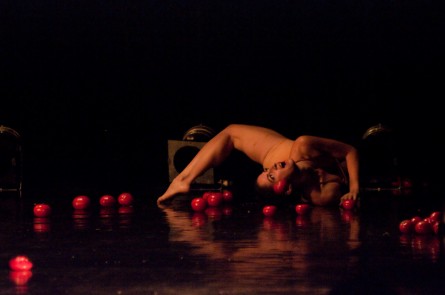
‘With an apple I will astonish Paris’ said Paul Cezanne, the French Impressionist painter. Well, Idan Cohen certainly astonished Delhi, albeit with the tomato!
Red round things on the stage. What were they? Tomatoes. Luscious and orange red in the yellow spotlights of the stage. They would be far from being just limp fruits by the end of the two hours on stage.
Edan Cohen and Group from Israel performed the Swan Lake at the India Habitat Centre on the 2oth of this month. Being an interpretation in contemporary dance, the classical Ballet , that was Tchaikovsky’s 19th century Swan Lake, transfigured before our eyes into a critically sublime modern day take on elemental questions of identity, beauty and control. Contrary and quite welcoming was that, here was a new , fresh and meditative reading of the Swan Lake, without succumbing to classicism in its original form, that was of the classical ballet with sculpted arched ballerinas striving towards an almost cruel perfection and the attempt of every being to become beautiful, from swan to human. Instead, Idan Cohen extracts the puppet strings of Swan Lake and embeds them so strongly into the present context, that it turns violent, grim and grey , from the humane to the animalistic.
There are only three dancers, Reut Levi, Rita Komisarchik and Daniel Gal who are continuously on the stage. And the performance juggles identities of the characters from the classical ballet, between these three bodies, each with their own symbolic markers, mixed with a grim disturbing undertone to it. At the beginning what looks like a prince who is having a birthday celebration, hinted by a child’s hat and a blowing whistle toy, slowly turns into a clown, with a red round nose. It is not coincidental that there are tomatoes on the stage after all. They become the critical clown-face of the beautiful, the sinful fruit of decadence, the toy, the tool of control, the blood of animalism, and eventually, a red sea that drowns the swans. The motif of this little fruit through its starkness on stage, as being the only prevailing element of stage design, evolves and grows on the dancers. The dancers enter the Swan lake as distinct individual identities, and emerge out of it stripped of paraphernal differences as a unified mass of mixed emotions, stripped of beautifications, and a violated rebellion of controlled selves.
Choreographed to the original composition with certain intermediate cuts, the movements we see on the stage are intense expressions emerging from the personality of each of the dancers. An element of control comes through strongly and may as well be a critique of the extreme severity of the ballerina’s physique and her training and at the constant attempt at sculpting and chiseling a body to achieve the bar of perfection. By creating motions resembling disembodied limbs and using the body as more of a dynamic tool of discord and turmoil, the dancers succeed to render this modern day Swan Lake, an unsettling, at times violent representation of the ambivalence of contemporary identity. The swan almost is the subaltern voice of the ‘self’. And as the first part ends with a methodical shedding (almost like a serpentine molting) away of the dancers external costumes, the voice of an internal struggle echoes against the silence of the classical orchestra. The second half opens to a visibly increased mass of red on the stage. The tomatoes are now more in number, and soon, they turn sinister as the dancers see hegemony inside their red and dance to crush them one by one, the smear looking like blood on their skin. Their movements turn primal and more animalistic , and finally, in a mass of entanglement , the sea of red consumes them.
The performance throws wide open the door to something new, fresh and brave, capped with a critical manner of sensitive contextual interpretation and a new language of expression. Idan Cohen’s reading of Swan Lake is a welcome gift to the seekers of the new like us. Thank you Idan.